Critical Thinking EAP Worksheets, Games & Activities
Fact vs. Opinion
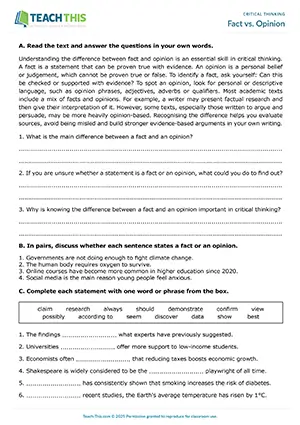
EAP Critical Thinking Worksheet - Reading and Writing Exercises:, Answering Questions - Speaking Activity: Discussion, Communicative Practice - Pair Work
In this free critical thinking worksheet, students learn the differences between facts and opinions and practice distinguishing between the two. First, students...
Identifying Logical Fallacies
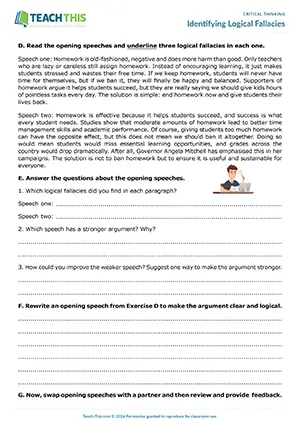
EAP Logical Fallacies Worksheet - Reading and Writing Exercises: Matching, Identifying, Rewriting a Speech - Speaking Activity: Discussion, Freer Practice - Pair Work
In this useful logical fallacies worksheet, students learn about common logical fallacies and practice identifying them. First, in pairs, students discuss three...
Critical Analysis Challenge

EAP Critical Thinking Activity - Speaking Activity: Discussion, Communicative Practice - Pair and Group Work
In this comprehensive critical thinking activity, students discuss realistic academic scenarios to practice key critical thinking skills, such as evaluating sources, identifying bias, and explaining logical fallacies...
Identifying Bias
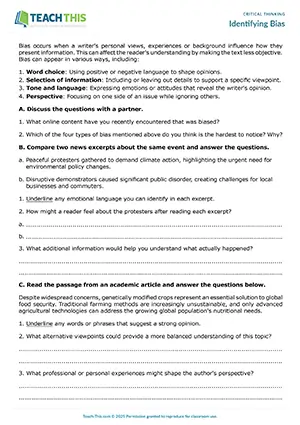
EAP Critical Thinking Worksheet- Reading Exercises: Identifying, Making Inferences - Speaking Activity: Discussion, Presenting, Freer Practice - Pair Work
In this identifying bias worksheet, students practice identifying bias through text analysis. First, students read a short introduction to bias. In pairs, students then...
Introduction to Critical Thinking
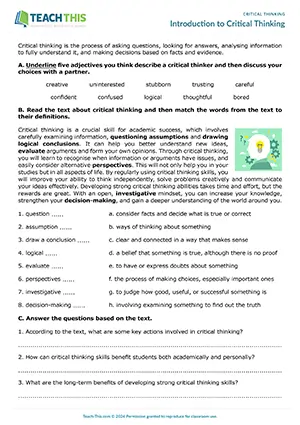
EAP Critical Thinking Worksheet- Reading and Writing Exercises: Paragraph Writing - Speaking Activity: Discussion, Freer Practice - Pair Work
In this critical thinking worksheet, students learn about critical thinking and examine a case study of the famous detective Sherlock Holmes, analysing how he uses...
Logical Fallacy Auction
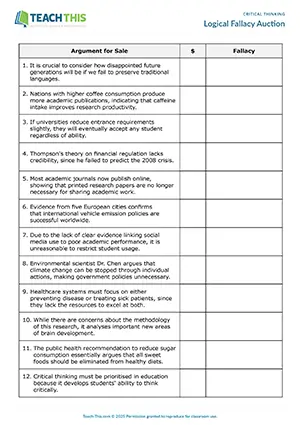
EAP Critical Thinking Game - Reading and Speaking: Identifying, Discussion, Giving Reasons - Group Work
In this entertaining logical fallacy game, students bid on arguments presented in an academic context and earn points by correctly identifying and explaining the logical fallacies they contain. Each team...
Logical Fallacy Bingo
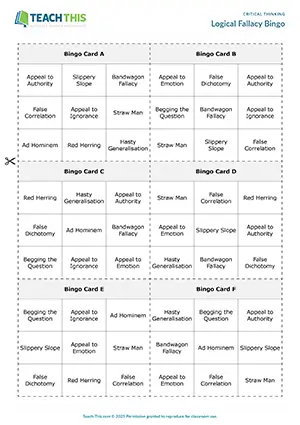
EAP Critical Thinking Game - Listening and Speaking Game: Bingo, Identifying, Explaining, Communicative Practice - Group Work
In this intriguing critical thinking game, students play bingo by identifying and explaining common logical fallacies in arguments. In groups, the...
Logical Fallacy Detectives

EAP Critical Thinking Game - Reading and Speaking: Identifying, Discussion, Giving Reasons, Communicative Practice - Group Work
This engaging critical thinking game helps students practice identifying and explaining logical fallacies in arguments. In groups, students read a logical fallacy...

